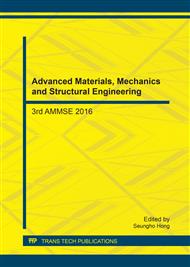[1]
B. Tieke, G. Lieser, G. Wegner, Polymerization of diacetylenes in multilayers, J. Polym. Sci.: Polym. Chem. Ed. 17(6) (1979) 1631-1644.
DOI: 10.1002/pol.1979.170170607
Google Scholar
[2]
A. Sarkar, S. Okada, H. Nakanishi, Polydiacetylene from asymmetrically substituted diacetylenes containing heteroaryl side groups for third-order nonliear optical properties, Macromolecules 31(26) (1998) 9174-9180.
DOI: 10.1021/ma981205j
Google Scholar
[3]
S. Okada, S. Peng, W. Spevak, D. Charych, Color and Chromism of polydiacetylene vesicles, Acc. Chem. Res. 31(5) (1998) 229-239.
DOI: 10.1021/ar970063v
Google Scholar
[4]
M. Leclerc, Optical and electrochemical transducers based on functionalized conjugaed polymers, Adv. Mater. 11(18) (1999) 1491-1498.
DOI: 10.1002/(sici)1521-4095(199912)11:18<1491::aid-adma1491>3.0.co;2-o
Google Scholar
[5]
D. T. McQuade, A. E. Pullen, T. M. Swager, Conjugated polymer-based chemical sensors, Chem. Rev. 100(7) (2000) 2537-2574.
DOI: 10.1021/cr9801014
Google Scholar
[6]
A. A. Deckert, L. Fallon, L. Kiernan, C. Cashin, A. Perrone, T. Encalarde, Kinetics of the reversible thermochromism in Langmuir-Blodgett films of Cd2+ salts of polydiacetylenes studied using UV-Vis spectroscopy, Langmuir 10(6) (1994) 1948-(1954).
DOI: 10.1021/la00018a054
Google Scholar
[7]
N. Mino, H. Tamura, K. Ogawa, Analysis of coloc transitions and changes on Langmuir-Blodgett films of a polydiacetylene derivative, Langmuir 7(10) (1991) 2336-2341.
DOI: 10.1021/la00058a060
Google Scholar
[8]
D. Charych, Q. Cheng, A. Reichert, G. Kuziemko, M. Stroh, J. O. Nagy, W. Spevak, R. C. Stevens, A 'litmus testʼ for molecular recognition using artificial membranes, Chem. Biol. 3(2) (1996) 113-120.
DOI: 10.1016/s1074-5521(96)90287-2
Google Scholar
[9]
J. M. Kim, J. S. Lee, J. S. Lee, S. Y. Woo, D. J. Ahn, Unique effects of cyclodextrins on the formation of colorimetric transition of polydiacetylene vesicles, Macromol. Chem. Phys. 206(22) (2005) 2299-2306.
DOI: 10.1002/macp.200500331
Google Scholar
[10]
N. Kato, F. Takahashi, Acceleration of deswelling of poly(N-isopropylacrylamide) hydrogel by the treatment of a freeze-dry and hydration process, Bull. Chem. Soc. Jpn. 70(6) (1997) 1289-1295.
DOI: 10.1246/bcsj.70.1289
Google Scholar
[11]
N. Kato, S. H. Gehrke, Microporous, fast response cellulose ether hydrogel prepared by freeze-drying, Colloids and Surf. B: Biointerfaces 38(3-4) (2004) 191-196.
DOI: 10.1016/j.colsurfb.2004.01.018
Google Scholar
[12]
D. C. Harsh, S. H. Gehrke, Controlling the swelling characteristics of temperature-sensitive cellulose ether hydrogels, J. Control. Release 17(2) (1991) 175-186.
DOI: 10.1016/0168-3659(91)90057-k
Google Scholar
[13]
B. Kabra, S. H. Gehrke, R. J. Spontak, Microporous responsive hydroxypropyl cellulose gels. 1. Synthesis and microstructure, Macromolecules 31(7) (1998) 2166-2173.
DOI: 10.1021/ma970418q
Google Scholar


